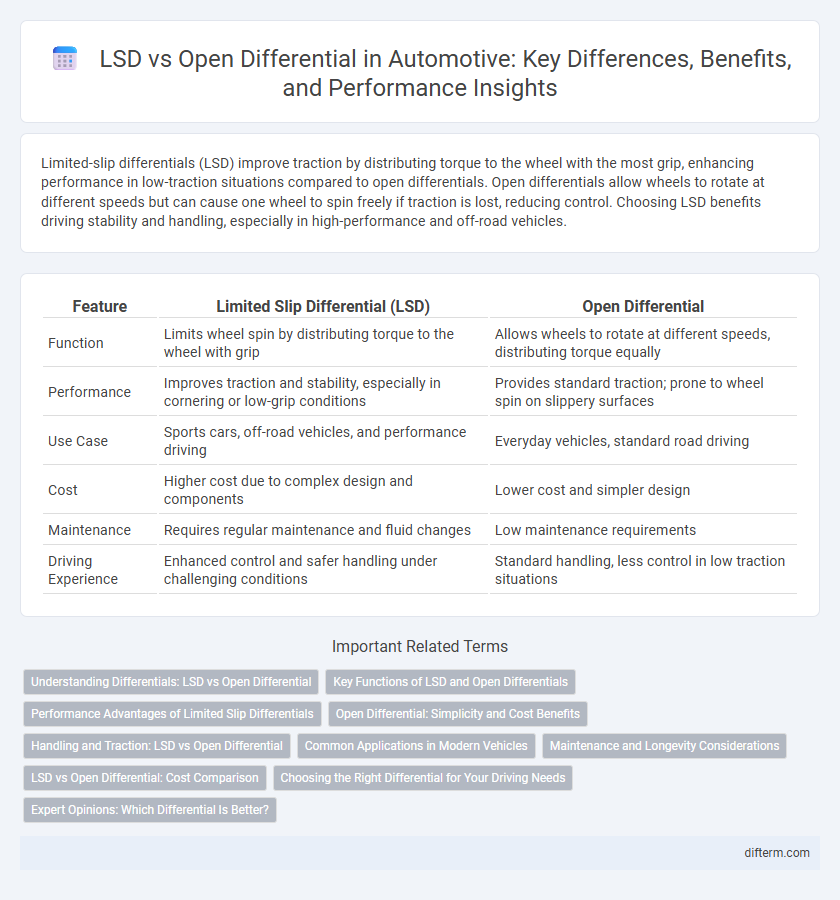Limited-slip differentials (LSD) improve traction by distributing torque to the wheel with the most grip, enhancing performance in low-traction situations compared to open differentials. Open differentials allow wheels to rotate at different speeds but can cause one wheel to spin freely if traction is lost, reducing control. Choosing LSD benefits driving stability and handling, especially in high-performance and off-road vehicles.
Table of Comparison
| Feature | Limited Slip Differential (LSD) | Open Differential |
|---|---|---|
| Function | Limits wheel spin by distributing torque to the wheel with grip | Allows wheels to rotate at different speeds, distributing torque equally |
| Performance | Improves traction and stability, especially in cornering or low-grip conditions | Provides standard traction; prone to wheel spin on slippery surfaces |
| Use Case | Sports cars, off-road vehicles, and performance driving | Everyday vehicles, standard road driving |
| Cost | Higher cost due to complex design and components | Lower cost and simpler design |
| Maintenance | Requires regular maintenance and fluid changes | Low maintenance requirements |
| Driving Experience | Enhanced control and safer handling under challenging conditions | Standard handling, less control in low traction situations |
Understanding Differentials: LSD vs Open Differential
Limited Slip Differentials (LSD) enhance traction by distributing torque between wheels, reducing wheel slip during acceleration or cornering, unlike open differentials that allow each wheel to rotate independently but can cause power loss if one wheel loses grip. LSDs improve vehicle stability and performance in challenging driving conditions by balancing torque more effectively across the axle. Open differentials provide smoother handling on dry pavement with consistent power delivery but may struggle on uneven or slippery surfaces where torque distribution becomes critical.
Key Functions of LSD and Open Differentials
Limited Slip Differentials (LSD) enhance vehicle traction by distributing torque to the wheel with the most grip, preventing wheel spin during acceleration or cornering. Open differentials allow wheels to rotate at different speeds, improving turning efficiency but can lead to loss of traction when one wheel slips. LSDs optimize power delivery for performance and off-road driving, whereas open differentials prioritize smooth handling and simplicity.
Performance Advantages of Limited Slip Differentials
Limited Slip Differentials (LSD) enhance vehicle traction by distributing torque more effectively between wheels, especially during cornering or slippery conditions. Unlike open differentials, LSDs reduce wheel spin and maintain better power delivery, resulting in improved acceleration and handling performance. This optimized torque management boosts stability and control, particularly in high-performance and off-road automotive applications.
Open Differential: Simplicity and Cost Benefits
Open differentials offer a simpler design that reduces manufacturing and maintenance costs compared to limited-slip differentials (LSDs). Their ability to allow wheels to rotate at different speeds improves everyday driving comfort and tire longevity. This cost-effective setup is ideal for standard vehicles prioritizing reliability and efficiency over high-performance traction.
Handling and Traction: LSD vs Open Differential
Limited Slip Differentials (LSD) provide superior handling and traction by distributing torque to the wheel with the most grip, reducing wheel slip during cornering or acceleration. Open differentials, on the other hand, allow wheels to rotate at different speeds but can cause loss of traction when one wheel slips, as torque is sent to the path of least resistance. In performance and off-road driving, LSD enhances stability and control, making it the preferred choice for improved vehicle dynamics.
Common Applications in Modern Vehicles
Limited Slip Differentials (LSD) are commonly used in performance and off-road vehicles to enhance traction by distributing torque to the wheel with the most grip, improving handling and stability in dynamic driving conditions. Open differentials dominate standard passenger cars and economy vehicles, offering smoother operation and reduced mechanical complexity, but they can struggle with traction on slippery or uneven surfaces. Modern SUVs and sports cars frequently integrate LSD technology to balance safety, performance, and drivability in diverse environmental conditions.
Maintenance and Longevity Considerations
Limited Slip Differentials (LSD) typically require more frequent maintenance than open differentials due to their complex internal components like clutch packs or viscous couplings, which can wear out over time and need regular inspection and fluid changes. Open differentials generally offer longer service intervals with simpler construction and fewer parts prone to failure, leading to increased reliability and reduced maintenance costs. Proper lubrication and timely fluid replacement significantly enhance the longevity of both LSD and open differentials, with LSDs demanding stricter adherence to maintenance schedules to prevent premature wear.
LSD vs Open Differential: Cost Comparison
Limited Slip Differentials (LSD) typically cost between $700 and $1,500, reflecting their advanced torque management and performance benefits compared to open differentials, which usually range from $200 to $500. The higher price of LSDs stems from complex mechanical components like clutch packs or gears designed to improve traction under varying driving conditions. While open differentials offer a more affordable option with simpler design and ease of maintenance, LSDs provide significant value for performance and off-road vehicles despite the increased initial investment.
Choosing the Right Differential for Your Driving Needs
Limited Slip Differentials (LSD) enhance traction by distributing torque to the wheel with the most grip, making them ideal for performance driving and challenging road conditions. Open differentials provide smoother operation and better fuel efficiency but can struggle with traction on slippery surfaces. Selecting the right differential depends on driving style, road conditions, and vehicle purpose, with LSDs favored for spirited driving and open differentials suited for everyday commuting.
Expert Opinions: Which Differential Is Better?
Experts often favor limited-slip differentials (LSD) for enhanced traction and improved cornering performance, especially in high-performance and off-road vehicles. Open differentials provide smoother operation and simpler maintenance but tend to struggle with wheel spin under low-traction conditions. Industry specialists highlight LSD's superior ability to distribute torque effectively, making it the preferred choice for driving enthusiasts and competitive motorsports.
LSD vs open differential Infographic

 difterm.com
difterm.com